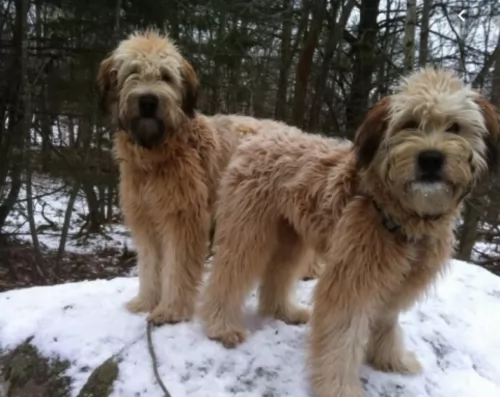 Petzlover
PetzloverBoth Doxiepom and Whoodles are originated from United States. Doxiepom may grow 23 cm / 9 inches shorter than Whoodles. Doxiepom may weigh 8 kg / 17 pounds lesser than Whoodles. Both Doxiepom and Whoodles has almost same life span. Both Doxiepom and Whoodles has almost same litter size. Both Doxiepom and Whoodles requires Moderate Maintenance.
The Doxiepom is a small dog known as a designer breed which has originated from crossing the well known Dachshund dog with another well known pure-breed dog, the Pomeranian.
This has resulted in the hybrid breed – the Doxiepom.
Both these pure bred dogs have their own history each but the Doxiepom is a new dog breed. It is believed that this mix of Pomeranian and Dachshund was originally developed in the United States in the 1990’s and while he doesn’t have much of a history, you can have a look at the history of the parent dog breeds.
 Known also as the Wheatenpoo or the Wheatendoodle, the Whoodle is a teddy-bear kind of mixed-breed dog, being a cross between Poodles and the soft-coated Wheaten Terrier.
Known also as the Wheatenpoo or the Wheatendoodle, the Whoodle is a teddy-bear kind of mixed-breed dog, being a cross between Poodles and the soft-coated Wheaten Terrier.
He came about in the mid-1900s so he is still quite a new breed. Like with most hybrid breeds, the Whoodle doesn’t have a well-documented history.
Because most hybrids hail from the USA, one can assume that the Whoodle comes from there as well.
The Doxiepom is a small dog - a cross between the Dachshund and the Pomeranian, and this means he can have characteristics from each of these breeds.
They’re short dogs, standing at roughly 12cm to 27cm. A full grown Pomeranian Dachshund mix can weigh between 3kg and 12kg.
With a fairly long body from the Dachshund side, he has floppy ears or they can be semi-erect and the tail is long.
You can’t really say what the dog will look like exactly and the coat may be long or short with some of the coat colors being tan, black or brown.
Their dependent nature can mean these little dogs battling with separation anxiety, and he is a dog that doesn’t like being left alone for long periods of time.
He easily attaches himself to just one member of the family while being friendly and loving to everyone else as well.
They’e fun loving, playful dogs and want to be involved in their family’s activities, whether indoors or out. They’re friendly, but are aloof with strangers. He makes a great watchdog too, barking when strangers enter the property.
 The Whoodle is a medium-sized dog that stands at between 30 and 50cm in height and weighs in the region of 9 to 20kg.
The Whoodle is a medium-sized dog that stands at between 30 and 50cm in height and weighs in the region of 9 to 20kg.
He has a silky, medium-length coat that can be fairly straight or wavy and which is available in a range of colors – black, brown, grey, cream and red.
He isn’t a heavy shedder, but their hair can grow fairly long so he will have to be groomed one way or the other. Many people choose to have him trimmed at the doggy salon. With the Poodle being in the mix, it is thought that the Whoodle coat is hypoallergenic, sought after by dog owners who suffer from allergies.
Just because of the dog breeds your Whoodle dog comes from, you can know that you’re going to have a playful, happy, friendly, outgoing, social pet who will have no doubt inherited a lot of good qualities from both parent breeds.
He will happily settle down with you in the city or the countryside. He absolutely loves human company and isn’t the kind of dog to be put outside for hours separated from his humans.
If there are children in the home, they’ll discover that this little dog is always up for a game. He gets on well with children and other pets. Early training and socialization will be imperative for the Whoodle as he is a strong-willed dog, inclined to be stubborn and you want to make sure he is obedient.
One of the strong characteristics of the the Doxiepom is that he shares a strong bond with his human family.
He is such a amicable little dog, ready to join in with the children in their games as well as in the activities of the adults.
He craves human companionship, and if you provide him with a happy home, he promises to give you devoted companionship throughout his life.
 The Whoodle is a hybrid dog – a mix between the soft-coated wheaten terrier and the poodle.
The Whoodle is a hybrid dog – a mix between the soft-coated wheaten terrier and the poodle.
They make splendid pets and companions and are cheerful and intelligent, wanting to be constantly by your side.
Because both of the parents are working dog breeds, he is an active dog too, loving to take part in all the activities his family is busy with.
When you bring this little teddy bear of a dog into your home, you’re going to have years of benefiting from a true canine companion.
The Doxiepom is a little dog who isn’t going to cost you a lot of time at the vet, however there are some typical dog illnesses that you will do well to know about.
Generally the Doxiepom has a lifespan of about 12 to 16 years and with good care, your pet can reach this age too.
As far as health problems go, your dog could be affected, although it is unlikely, as he is a robust dog breed.
Your pet could inherit health problems more common to either of the breeds. Little dogs suffer with their own set of heath problems and these could be back problems, dental- and eye disease and allergies.
A common health problem with a small dog like this is obesity. They don’t need a lot of food but because they’re so friendly and entertaining, some owners over-feed them.
 The Whoodle is considered to be a healthy little dog but they can suffer from some of the many common dog illnesses there are. It’s important to feed your dog well and to exercise him to ensure his good health. Some of the common health problems he could suffer with -
The Whoodle is considered to be a healthy little dog but they can suffer from some of the many common dog illnesses there are. It’s important to feed your dog well and to exercise him to ensure his good health. Some of the common health problems he could suffer with -
It is important to ensure your Whoodle has his vaccines to prevent some of the deadly canine diseases there are.
Also, it is a good idea to have your pet neutered or spayed to prevent an unwanted litter. Spaying and neutering have health benefits for your pet, so it is a good idea to have this done for them.
The Doxipom has moderate grooming requirements, shedding somewhat throughout the year, so brushing him twice a week will keep the coat shiny and healthy.
If your pet has turned out to have more long hair than short, he may require some professional grooming. His nails will also need clipping and his ears will also need to be checked for infection.
Small dogs often battle more with dental and gum problems, and plaque and tartar buildup results when food gets trapped between the teeth, leading to gingivitis which can lead to premature tooth loss. Keeping the teeth clean is therefore important.
Small dogs have quicker metabolisms than big dogs and they also mature faster than the larger dogs. Smaller dogs actually require more calories per kilogram than big dogs because they burn up energy faster than larger breeds.
It is therefore important to feed your small dog the right amount of food to support their growth rate and to maintain weight in adulthood. Homemade foods for your Doxiepom are always wonderful, but of course many people who work make use of some of the good commercially manufactured dog foods out of sheer convenience.
Go for the better quality brands which have top ingredients in them so as to avoid deficiencies.
Raw meat should also make up part of the diet – fish, chicken and red meat. Always make sure your pet has access to fresh, cool water.
 Apart from your Whoodle requiring regular nail trimming, you will want to brush him twice a week to keep their coat free from matting. Some Whoodle owners prefer to have their pets professionally groomed.
Apart from your Whoodle requiring regular nail trimming, you will want to brush him twice a week to keep their coat free from matting. Some Whoodle owners prefer to have their pets professionally groomed.
Check inside his mouth while grooming to ensure there are no bad teeth. This could cause your pet a lot of pain and he has no way of telling you this.
As a medium-sized dog, you want to feed your pet a commercially manufactured dog food that has been formulated for a medium-sized dog and one with lots of energy.
Their dietary needs change from puppyhood to adulthood and where the puppy received 4 bowls of food a day, the adult Whoodle will require 2. Always buy the best quality food you can as the choice of food you provide has a huge impact on his health.
Some home-made food is always a good idea too but it needs to be simple and plain, without any exotic spices. Boiled chicken, rice and vegetables is always a splendid choice and it can be added to the dry kibble as a supplement.